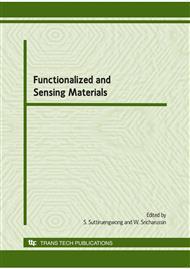p.22
p.27
p.31
p.35
p.39
p.43
p.49
p.59
p.63
Graft Copolymerization of Methyl Methacrylate onto Natural Rubber by Microwave Irradiation
Abstract:
The graft copolymerization is one chemical modification methods to improve natural rubber (NR)’s properties via both solution and latex phases. To enhance the polarity of NR, methyl methacrylate (MMA) was applied for graft copolymerization of NR in the presence of thermal or redox initiators. However, the conventional graft copolymerization generally spends long reaction time (ca. 6-8 h). Due to less energy consumption with faster heating rate, the microwave irradiation was used to induce graft copolmerization of MMA onto NR latex using redox initiation system. By comparing with the conventional grafting method at the same grafting properties, the graft copolymerization of MMA onto NR induced by microwave at 100 W spent the shorter reaction time ca. 15 min; whilst, the conventional method required the longer reaction time as 7 h. The influence of microwave power on the grafting properties was investigated. The structure of graft product was also analyzed by using FTIR and 1H NMR spectroscopy.
Info:
Periodical:
Pages:
39-42
Citation:
Online since:
January 2010
Keywords:
Price:
Сopyright:
© 2010 Trans Tech Publications Ltd. All Rights Reserved
Share:
Citation:


